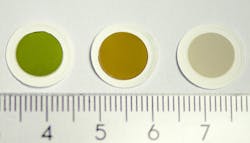Carbon in color: First-ever colored thin films of nanotubes created
| Samples of green, tan, and light gray carbon nanotube thin films, as produced in the fabrication reactor. Image: Aalto University. |
Researchers at Aalto University (Aalto, Finland) have presented a technique to produce large quantities of pristine single-walled carbon nanotubes in select shades of the rainbow. 1(By nature, single-walled carbon nanotubes are typically black or a dark grey.) The secret is a fine-tuned fabrication process—and a small dose of carbon dioxide.
The researchers believe this is the first time that colored carbon nanotubes have been produced by direct synthesis. Using their invention, the color is induced straightaway in the fabrication process, not by employing a range of purifying techniques on finished, synthesized tubes. For example, with 0.25 and 0.37 volume percent of carbon dioxide, the nanotube films display green and brown colors, respectively.
With direct synthesis, large quantities of clean sample materials can be produced while also avoiding damage to the product in the purifying process, which makes it the most attractive approach for applications.
Possible use in photovoltaics
"In theory, these colored thin films could be used to make touch screens with many different colors, or solar cells that display completely new types of optical properties," says Esko Kauppinen, a professor at Aalto University.
The underlying technique needed to enable the coloration imply finely detailed control of the structure of the nanotube structures. Kauppinen and his team's method, which starts with aerosols of metal and carbon with small doses of carbon dioxide administered, allows them to carefully manipulate and control the nanotube structure directly from the fabrication process.
"Carbon dioxide acts as a kind of graft material that we can use to tune the growth of carbon nanotubes of various colors," explains Hua Jiang, a senior scientist at Aalto University.
Using an electron diffraction technique, the researchers were able to find out the precise atomic-scale structure of their thin films. They found that they have very narrow chirality distributions, meaning that the orientation of the honeycomb lattice of the tubes' walls is almost uniform throughout the sample. The chirality more or less dictates the electrical properties carbon nanotubes can have, as well as their color.
The method developed at Aalto University promises a simple and highly scalable way to fabricate carbon nanotube thin films in high yields. Follow-up work is already underway.
Source: http://www.aalto.fi/en/current/news/2018-08-28/
REFERENCE:
1. Yongping Liao et al., Journal of the American Chemical Society (2018);doi: 10.1021/jacs.8b05151.
